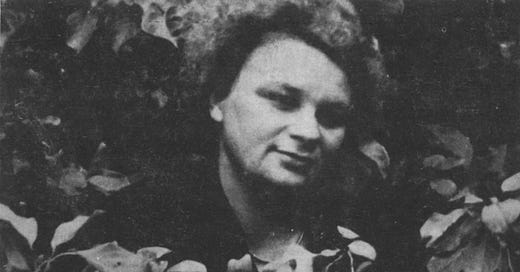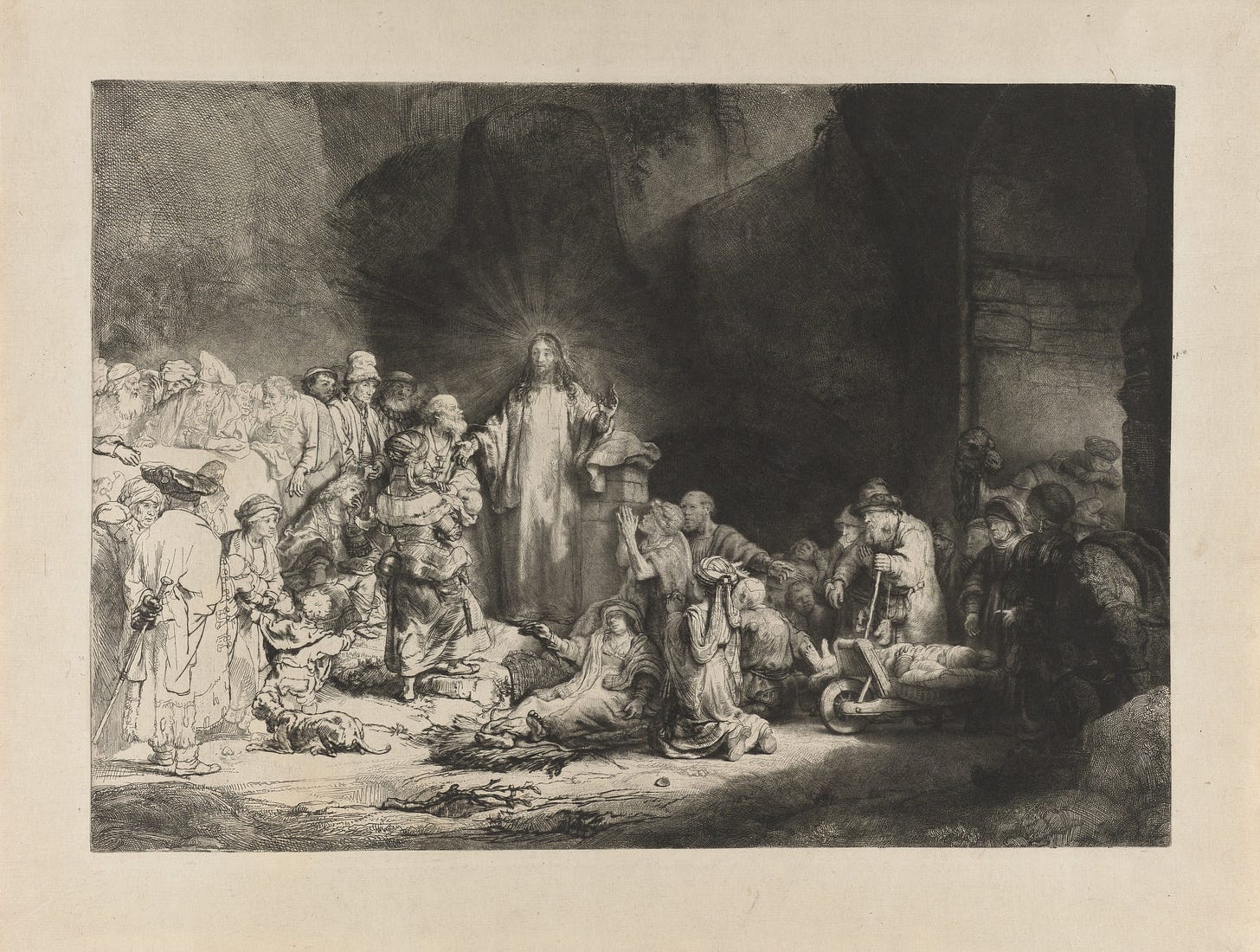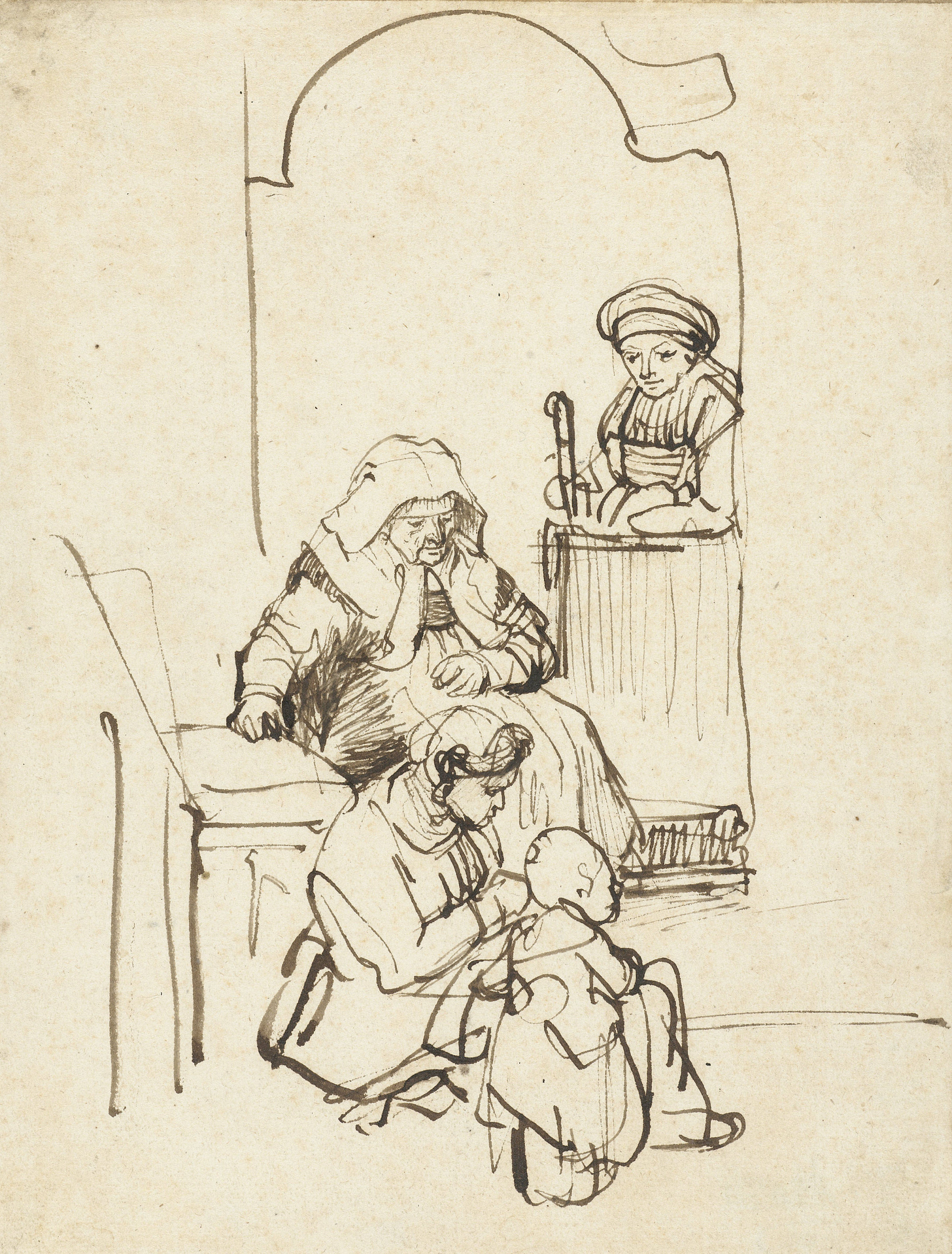Anna Kamieńska and the need for human art in a technocratic world
“The ways of creating that are a prayer. The ways of being that are a prayer."
Art if human
is born out of pity
out of affinity
with the terror of the mortal
-from "Rembrandt"When I read these lines from the Polish poet, Anna Kamieńska, they immediately struck me as presenting as good an explanation as can be found for why AI generated art can never substitute human made art. A machine can never pity the human person’s plight. It can never know what it’s like to fear death. But this is what, Kamieńska writes, “connects us most closely as people…not strength, but weakness, helplessness, fear, death. The face of suffering,” she continues, “is the same. Christ’s face.”1
Further on in the poem “Rembrandt”, she writes that Rembrandt’s “Christ stood on the threshold of a ray of light / just before taking a step into human helplessness / Like every artist Christ is / sorrowful and lonely”.2 For Kamieńska, true art is personal and humanizing because the artist is intimately linked to the person of Christ, who is both human and the one through whom we receive our humanity.
An artist must be like Christ stepping into human helplessness to give the consolation of pity and affinity out of his own experience of sorrow and loneliness.
Anna Kamieńska’s own work is thoroughly human and humanizing. You can sense the particular woman behind the poetry, and you also come away from her poems being reminded of your own humanity: of your frailty yet inborn desire for eternity, of the paradoxical solidity yet transience of your body.
Kamieńska’s poetic wisdom was shaped by her own witness to and personal experience of suffering. She came of age in Poland during the dehumanizing events of World War II and Communism. The death of her husband in middle age thrust her into a struggle between faith and despair until she eventually returned to the Catholic faith she had long abandoned.
Though she deals with weighty themes, Kamieńska’s writing is unaffected, mixing the transcendental with the quotidian. ‘Incarnational’ is a word that is perhaps over-applied to art, but in Kamieńska’s case, it is fitting. Consider her poem, “Small Things”3:
It usually starts taking shape from one word reveals itself in one smile sometimes in the blue glint of eyeglasses in a trampled daisy in a splash of light on a path in quivering carrot leaves in a bunch of parsley It comes from laundry hung on a balcony from hands thrust into dough It seeps through closed eyelids as through the prison wall of things of objects of faces of landscapes It's when you slice bread when you pour out some tea It comes from a broom from a shopping bag from peeling new potatoes from a drop of blood from the prick of a needle when making panties for a child or sewing a button on a husband's burial shirt It comes out of toil out of care out of immense fatigue in the evening out of a tear wiped away out of a prayer broken off in mid-word by sleep It's not from the grand but from every tiny thing that it grows enormous as if Someone was building Eternity as a swallow its nest out of clumps of moments
Here, Kamieńska catalogues many ordinary, incarnate things: parsley and potato peels, a drop of blood and a tear wiped away. She emphasizes that invisible, domestic tasks, too often eschewed as drudgery, are actually wholly human and dignifying, and that these tasks situated in our immediate reality are, rightly seen, a portal to transcendence.
Though she lived through major historical upheavals of the 20th century, she doesn't look to man’s machinations as that which is of the most enduring substance. The lowliest, analog things, the silent, unpublicized moments, the concrete acts that constitute the “toil of care” for the specific people in our lives are what connect us to heaven—a reality that will be characterized by a communion of persons.
Kamieńska’s beliefs on life and art are saturated in the philosophy of personalism—in this emphasis on the dignity of each human person, a dignity that ought to be conferred on one’s work and dealings with other people. In the sphere of music, she writes beautifully on how a composer imprints the dignity of his own person on his work:
Music is a returning time. Rolled coils of time. Time flowing through specific creative individuals, thus personalized. The time of Beethoven, the time of Brahms, the time of Chopin, the time of Mozart. These times—so different in their flow, temperaments, energies—submit, however, to the general rules of time. There are always two slanted present tenses: the past and the future. And yet, once we grasp the entire music, it has a quality of enduring, a touch of eternity.4
In listening to a sublime piece of music fashioned out of a particular person’s genius, we are freed momentarily from the pressures of temporal time and our yearning for eternity is aroused. We are reminded that we are not mere animals unable to lift our eyes from demeaning work or addictive entertainment, but free beings made to participate in rapturous, eternal union with our creator.
The technological encroachments of our age seek to remake us into beings that are frenetically active yet less human—less connected to the incarnational acts of care and creation, distracted from suffering and any meaning it might hold, and alienated from our final end in Heaven in favor of the man-made illusion of eternity that is the infinite scroll feature. Identity, instead of being something sacredly received, has become an independently contrived thing, something to brand and re-brand lucratively anew. And algorithms convince us that our purpose is to produce and consume as much content as possible.
In an era long before you could find Instagram poetry met with instant praise and wedged between ads, Kamieńska worried that “we demand less and less of poetry. Just a nudge or a sting to our imagination and thought. For this,” she says, “you don't need more than a few words. Sometimes entire long poems pass through us like air. We rush to the final point, to the conclusion. All of it results from a shortening of the inner time of art, perhaps also of man.”5
At another point in her journal, Kamieńska quotes Simone Weil: “Contemplation of time is a key to human life.”6 But how can this idea be reconciled to a world where there is no time for contemplation? In a world where time is completely against us, where “the slanted present tenses” of past and future bear down mercilessly upon us? Such words are little comfort to the content creator trying to win followers and gain traction. If she doesn’t follow the rules of the online sphere, she will become be replaced and forgotten. It’s no surprise that when the inherent dignity of the person is not a given, because we’ve lost sight of our true origin and end, we become unmoored in a sea of anxiety.
I’d be curious to hear what Kamieńska would have to say about this state of affairs were she alive today, but this journal excerpt provides a succinct answer: “You shouldn’t be anxious when you don’t write. Perhaps someone writes then in us a more important text.”7
When we create art, our art should bear the mark of our person, not artificially or egotistically, but in a way that reminds the creator and beholder that there is someone who endows each of us with our unique personhood—someone who “writes in us”. In her poetry, Kamieńska strove “to approximate the impossible, where the art disappears and the Word becomes.”8
I’ll leave you with one more poem that especially moved me. It’s a beautiful meditation on the wonder of childhood, which is perhaps the only time of life when we don’t feel the acute “slanted present tenses” of past and future, but are innocently disposed to contemplation.
Faced with the modern tendency to over-share and desecrate our private experiences, might we all be faithful to our “first astonishments” and to quietly carry in ourselves “a path in the woods of [our] childhood[s]”.
“A Path in the Woods”9
I don't trust the truth of memories because what leaves us departs forever There's only one current of this sacred river but I still want to remain faithful to my first astonishments to recognize as wisdom the child's wonder and to carry in myself until the end a path in the woods of my childhood dappled with patches of sunlight to search for it everywhere in museums in the shade of churches this path on which I ran unaware a six-year old toward my primary mysteriousness aloneness
Kamieńska, Anna. Astonishments: Selected Poems of Anna Kamieńska. Translated and edited by Grażyna Drabik and David Curzon, (Brewster, MA: Paraclete Press, 2007) 119.
Ibid., 100
Ibid., 45
Ibid., 117
Ibid., 128
Ibid., 130
Ibid., 122
Ibid., 129
Ibid., xix









Lovely, I will have to order a book of her poetry. This piece aligns similarly to what I’m trying to write right now and struggling to articulate.
Beautiful post about a poet who deserves more attention. Dziękuję.